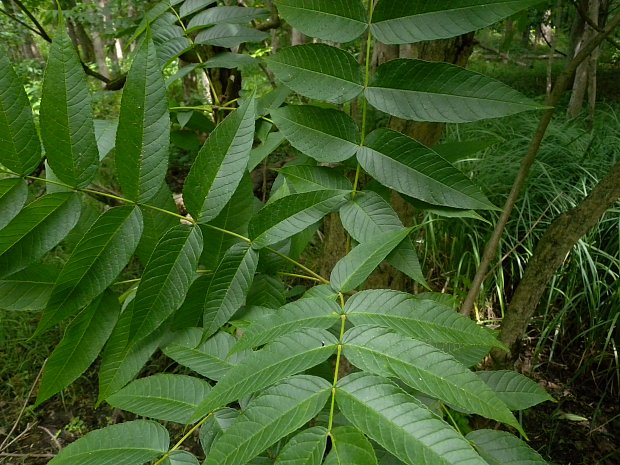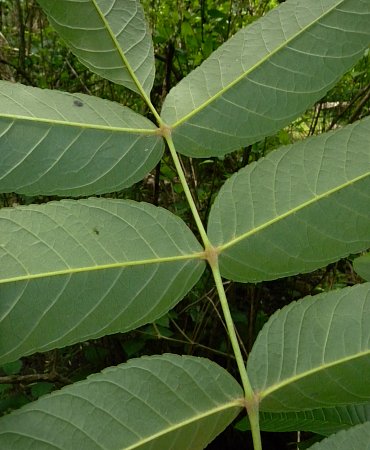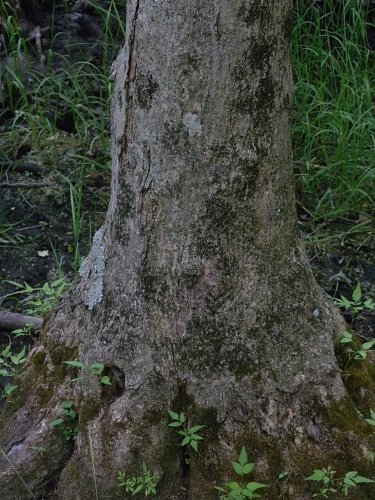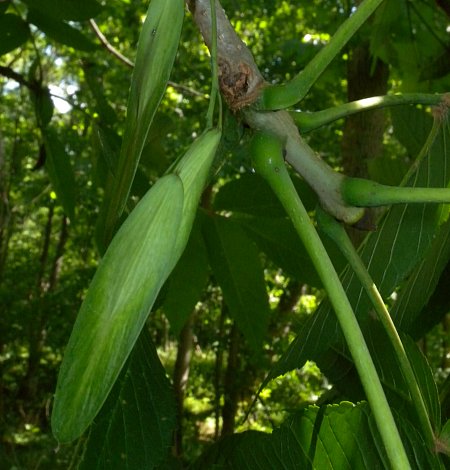
Black Ash can be either dioecious or monoecious; it less commonly produces perfect flowers. These purplish flowers are produced in compact clusters during the spring before the vernal leaves develop. Male flowers are about 3 mm. (1/8") long, each one consisting of a pair of stamens; they lack calyces and corollas. Female flowers are about 3 mm. (1/8") long, each one consisting of a pistil; they lack corollas and their calyces are absent or insignificant. These flowers are cross-pollinated by the wind. Afterwards, fertile female flowers are replaced by single-seeded samaras that are narrowly oblong in shape, about 1-1½" long, and 6-8 mm. across. These samaras are more tapered at their bases than at their tips; the latter are rounded or slightly notched. Except where their seeds occur, the samaras are flat. The winged membranes of the samaras extend downward past the edges of the seeds to their bases. The samaras are distributed by water or wind. The root system is widely spreading and shallow. This tree spreads by reseeding itself.

Cultivation: The preference is full or partial sun, wet conditions, and soil containing loam, sandy loam, clay-loam, or peaty material. This tree has a wide pH tolerance. The seeds can take 2-3 years to germinate. Black Ash usually lives up to 150 years, although some trees may live up to 250 years. Flooded conditions can be tolerated for up to 2 months during the growing season.
Range & Habitat: The native Black Ash (Fraxinus nigra) is occasional in northern Illinois, uncommon in central Illinois, and rare or absent in the southern section of the state (see Distribution Map). Illinois lies along the southwestern range limit of this mostly boreal species. Habitats include swamps, flatwoods, shady seeps and springs, White Cedar fens, wet depressions in wooded areas, low areas along lakes, and forested bogs. In Illinois, this tree is found in higher quality natural areas. In deciduous woodlands, common associates of this tree include Acer saccharinum (Silver Maple), Fraxinus pennsylvanica (Green Ash, Red Ash), Quercus bicolor (Swamp White Oak), and the herbaceous Caltha palustris (Marsh Marigold). Black Ash is able to survive top kill from a wildfire by resprouting from the base of its trunk.

Faunal Associations: Various insects feed on the leaves, wood, plant juices, and other parts of Black Ash and other ash trees (Fraxinus spp.). These insect feeders include the larvae of wood-boring beetles, leaf beetles, weevils, larvae of gall flies, plant bugs (especially Tropidosteptes spp.), aphids, armored scales, larvae of sawflies, and larvae of many moths (see Insect Table). The seeds of these trees are eaten by such birds as the Wood Duck, Wild Turkey, Bobwhite Quail, Ruffed Grouse, Northern Cardinal, Evening Grosbeak, Pine Grosbeak, Purple Finch, and Red-winged Blackbird. The Yellow-bellied Sapsucker sometimes drills holes into the trunks of these trees to feed on the sap (Martin et al., 1951/1961; DeGraaf, 2002). Black Ash and other ash trees are also used as daytime roost sites for some species of birds and bats, including the Eastern Screech Owl, Hoary Bat, Northern Long-eared Bat, Tricolored Bat, and Indiana Bat (Belthoff & Ritchison, 1990; Baerwald et al., 2012; Krynak, 2010; Veilleux et al., 2003; Carter, 2003). Mammals that feed on these trees include the American Moose and White-tailed Deer (twigs, foliage), American Beaver and North American Porcupine (bark, wood), Fox Squirrel and White-footed Mouse (seeds). Because Black Ash occurs primarily in forested wetlands, it provides habitat and cover for such amphibians as tree frogs, wood frogs, and spring peepers.

Photographic Location: An oak flatwoods and shady seep at the Horseshoe Bottoms in Vermilion County, Illinois.
Comments: Among the Ash trees (Fraxinus spp.) in Illinois, Black Ash (Fraxinus nigra) has the most northern distribution and it is usually smaller in size. Other common names of this tree include Basket Ash, Hoop Ash, and Swamp Ash. The wood of Black Ash is relatively soft and flexible. It is relatively easy to split and can be separated into thin strips. The wood has been used to make cabinets, veneer, baskets, barrel hoops, and the seats of chairs. Black Ash can be distinguished from other ash species by its sessile lateral leaflets and by the tufts of short brown pubescence on the bases of its leaflet undersides and adjacent areas of its rachises. The trunk bark of Black Ash is also unlike its counterparts in this genus: it is relatively smooth, flaky, and irregularly fissured. In contrast, both White Ash (Fraxinus americana) and Green/Red Ash (Fraxinus pennsylvanica) have coarsely textured trunk bark with deep interlacing furrows and ridges.